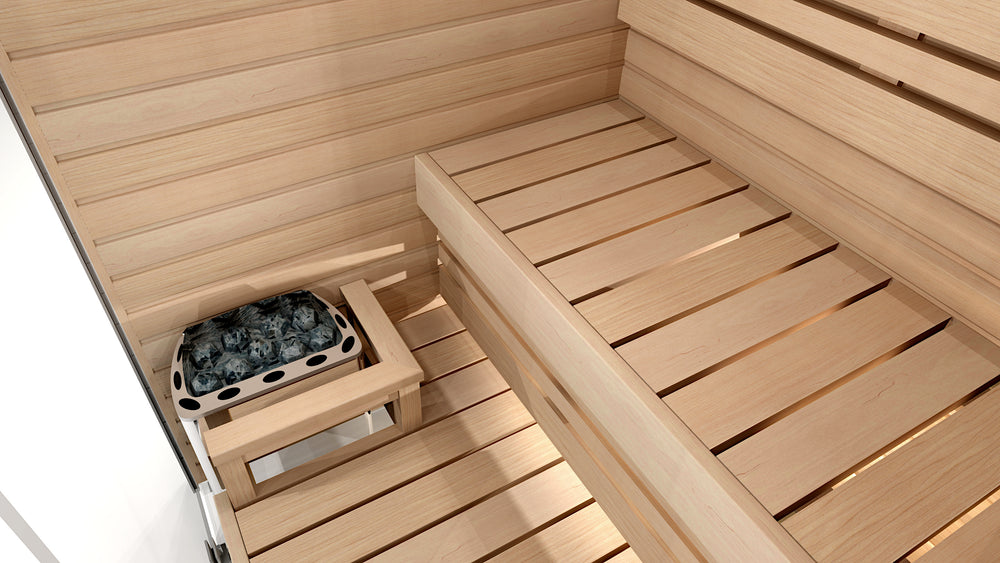Frequently Asked - About Sauna Installation
Verify from your local building administration if you need a permit. Normally a building permit is not needed, since a pre-built selfstanding sauna is just set up in a place that is suitable for a sauna. Same as a building permit is not needed to install a washing machine. However sometimes an inspector or a landlord will want to understand and verify what effect the sauna has on the building structures and ventilation system. Saunastore is ready and willing to help you answer these questions. You should check that your electrical connection is suitable and the space is large enough.
The amount of moisture from the sauna bathing is normally lower than the moisture evaporating from a shower, and at the same time sauna warms a bit also the room where it is and helps keep it dry. If the existing ventilation system is working well, then it will be fine for the sauna. However if you plan to install the sauna in a room where ventilation is poor, then you need to consult a specialist. As a standard feature the saunas have an air fan that takes air from the room and pushes it into the sauna, and the air to returns to the room from under the walls. The heat will stay in the sauna remarkably well, except when you open the door, but that bit of hot air will easily be extracted by your ventilation or diluted into the room air. So, there are very seldom any problems or restraints.
The saunas do not have a floor, so in case of indoor sauna the room floor must be watertight, such as a tile floor, and it should preferably have a floor drain. It is inevitable that there are some splashes and sweat drops on the floor. The base where an outdoor sauna will be installed can typically tolerate water, so the attention is focused to the base being absolutely flat and on horizontal level, and being able to support the weight of the sauna. However the sauna weight is divided along the wall perimeter, so typically that is not a problem.
Pre-built means you have a sauna ready for installation, build kit means that you have a set of materials for construction. In terms of end result in sauna bathing there is no difference. A build kit project involves a lot of sawdust, noise, machinery, workmen stepping aroung with their boots and carrying dirt everywhere. A build kit sauna typically requires building permits, with plans for ventilation upgrades, electrical work etc. A build kit sauna is built from scratch on site, and therefore the construction time and disturbance is much greater compared to a pre-built sauna, which is quickly assembled from parts. In a ready sauna there is no need for sauna designing, no sauna construction experience is required from the persons making the installation. Also as the installation work is quickly done, typically a ready built sauna is lower in total cost. A pre-built sauna is not permanently attached to the room and therefore is in many locations considered by law as only a piece of furniture. However, a build kit sauna is the right choice when a house is built and it can be included in the design, or a room is converted to a sauna.
Our saunas are all ready saunas. Many of our customers do the sauna installation by themselves, but you should definitely have some experience in assembly or construction with, cordless powertools. It is not difficult, apart from some of the parts being quite heavy and not possible to carry or lift by one person. It is recommended that you hire professional installers to do the installation. The parts are attached together one-by-one, with screws, and thus it is not rocket science. An indoor sauna typically can be installed in one day, most two, but an outdoor sauna will typically take 2-3 days in all. All electrical installation requires an electrician to make the connections, for liability reasons.
You will need a licensed electrician to connect the heater, sauna light and fan. In European 230V 1 phase systems, a 16A fuse is sufficient to connect saunas and heaters up to 3,6 kW. Larger 400V 3 phase connection requires more substantial electrical installation work. You need to consult your electrician before the purchase of the sauna so that we can deliver you the correct sauna and heater model. Then there are local regulations regarding how the electricity is connected: in some countries 230V 1-phase it often is possible just to plug in to a regular wall outlet, but in many cases a fixed installation is required.
No, an indoor sauna is designed for only indoor use, so as not to have rainwater on its walls or roof. We know some customers have installed indoor saunas on a covered terrace, but this is fully their responsibility. We have outdoor saunas for outdoor installation, and if you wish a different size or design of outdoor sauna from what we have, contact us and we will gladly explore how we can meet your needs.




